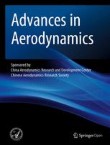Advances in Aerodynamics is affiliated with the with Computational Aerodynamics Institute, China Aerodynamics Research and Development Cernter and Chinese Aerodynamics Research Society.
Effect of tip clearance on non-synchronous propagating flow disturbances of compressor rotors under high aerodynamic loading conditions
The complex tip flow instability and its induced non-synchronous vibration have become significant challenges, especially as aerodynamic loading continues to increase. This study investigates the effects of ti...

 ...
...